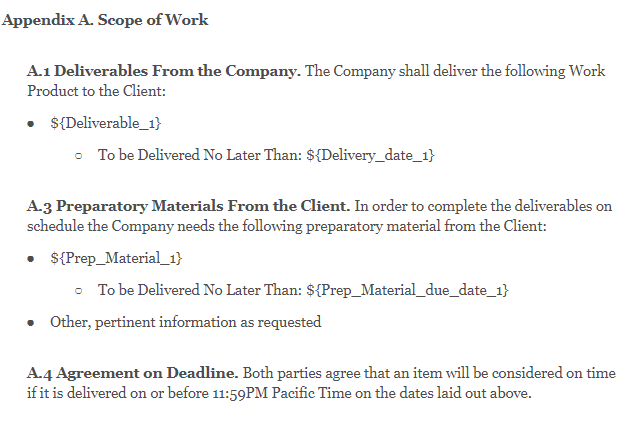
6 elements of a 6-figure freelance contract
A good freelance contract protects both the freelancer and the client — and yet too many new freelancers skip this step entirely.
I get it though: Sometimes you just want to do the work and get paid (especially in the beginning).
Also you can’t help but feel like you’re trying to buy someone’s soul with a contract.
“I’ll write the sales page, and you give me your soul and that of your first-born son. Sound fair?”
However, having a freelance contract ready helps you and your client be clear on what’s expected and can help protect you down the road.
Let’s take a look at why a freelance contract is important, then break down the six elements needed for a winning contract.
What is a freelance contract?
A freelance contract is a signed agreement between a freelancer and the client. It outlines the deliverables from the freelancer as well as what is to be expected from both parties.
It also serves a variety of other purposes:
- Protection. A freelance contract protects both the freelancer and the client by outlining the exact work that’s expected of you. So if your client expects more work for the same amount of pay, you can point to the contract and show them it’s not part of the agreement. Likewise, if you don’t fully deliver on your work, the client can hold you accountable since you have an agreement in writing.
- Psychological. The freelancer and the client also benefit from the peace of mind that comes with a contract. This can be a huge gain psychologically. Having a physical contract you both can refer to can help when you’re working with a new client and you’re trying to establish a good working relationship.
- Professional. There’s little that’ll make you look more like a pro than having your own contract ready. With it, you’ll come off as experienced, reliable, and ready to work no matter what your level.
Having a good freelance contract prepared also helps you keep a detailed record of all the work you do. That way, when it comes time to request payment, you won’t have to dig through your inbox or make a ton of phone calls to prep your invoice. You can just refer back to the contract!
It’s worth mentioning now that I am not a legal expert — but I can say that a freelance contract can give you a better chance of coming out on top if things with your clients break bad and you end up in court over an issue. As with most legal issues, this should serve as an informational guideline and you should consult your own lawyer for your own personal situation.
If that happens, though, you just learned a valuable lesson: Respect your own time enough that you never work with a client like that again.
KISS: The cornerstone of every good contract
The main thing to keep in mind with freelance contracts is KISS.

Rock and roll all night and protect your professional interests every day.
Keep it simple, stupid.
It’s easy to get carried away and try to cover every conceivable possibility. However, you run the risk of confusing your client. At worst, you might end up scaring them off with a contract that reads longer than War and Peace.
Instead, write with simple, straightforward language. Your contract doesn’t have to be “legalese” to be legal. You want your client to be able to take a look at this over their lunch break and understand all the terms outlined.
While keeping it simple, you also need to make sure you’re very specific about expectations. That way all parties involved know exactly what is to be expected from the other.
This is the tenuous balance you have to strike. But when you do so, you’ll come up with a contract template perfect for your and your client’s needs.
6 elements of a 6-figure contract
We’re going to take a look at a contract used by Will Green, friend of IWT and copywriter extraordinaire.
“I’ve used the contract for a lot of freelance work [amounting more than six figures],” Will says. “It’s been reviewed by lawyers and it’s held up in court.”
However, he’s also quick to remind us that he’s no lawyer. In his experience, though, this contract has served him well.
And the contract works because it adheres to six concepts:
- The Introduction
- The Work
- The Scope
- The Payment
- The Copyright
- The Termination
Let’s take a look at each element now and break down how it works.
NOTE: This is just one example of a freelance contract — however elements used within can be applicable to your freelance contract as well.
The Introduction

Like any good news story, you’re going to put the most important pieces of information first.
Your introduction then is going to be a short outline of the relationship between you and the client.
Notice how this contract also specifies who is the “client” and “company.” This will be relevant throughout the rest of the contract as you’ll be referring to those terms.
The Work
This is where we get into the meat of the matter: Deliverables.
You’ll want to get this section as specific and focused as possible. That means including the following at minimum:
- Project. An overview of what you’ll be doing for the client.
- Timeline. When you’re expected to start and be finished with the project.
- Payment. How you’re expected to be paid (e.g., hourly, retainer, per project) and when the client will pay you.
Notice how these areas are deferred into separate appendixes. These are entirely different areas of the contract dedicated to those subjects. Very useful if there’s a lot of detail that you need to include.

If you can explain it quickly though, there’s no reason you can’t just include the details in this section.
The Scope

This section is where specificity will really need to shine, as it helps protect you from the dreaded “scope creep.”
This is when a client keeps asking for more work than you agreed to, or asking for changes to the work you’re currently doing.
Scope creeping most often occurs when the project isn’t clearly defined. That’s why it’s so important to be as focused as you can in your contract and the work you both agree upon.
This freelance contract dedicates more than a page to the scope and includes exactly what the freelancer will deliver, the deadline for the project, as well as what the client will deliver.
Of course, if either you or your client wishes to change the scope of the project, you can always change the price — which brings us to …
Want to build a business that enables you to live YOUR Rich Life? Get my FREE guide on finding your first profitable idea.
The Payment

Arguably the most important section of the contract to a freelancer.
Be as focused and specific as possible when you’re outlining how and when you’re going to get paid. Never leave room for interpretation in this section.
Doing so could allow your client to delay paying you, pay you less than what you agreed to, or worse: Not pay you at all.
At a minimum, you should include the following pieces of information:
- How much you’re going to be paid.
- Precise timeline or schedule of payment from your client.
- Cancellation fee if you or your client terminates the contract.
That last part is important. This allows you to get something for your work even if the client decides to drop your services — which brings us to …
The Termination

This section is for when things between you and your client just aren’t working out. It allows either party to split from the agreement under agreed upon terms.
In this freelance contract, that means an “email or letter” to the other party with a week’s worth of notice.
It’s very important to include that buffer time. There’s nothing worse than having a client cancel a contract with no notice — leaving you without work or time to look for more work.
The Indemnity

This is the legal section of your contract — and it’s there to protect you from the worst case scenario.
This can include things like not getting paid, getting sued by your client, or if your client runs into legal trouble associated with your work.
The legal term for it is “indemnity,” or the protection against legal responsibility. Notice this contract gives the client AND the freelancer indemnity from legal issues such as “gross negligence.”
NOTE: A bit of legalese knowledge is required for this section — more than IWT can provide. Our advice: Consult an attorney or find an organization that can provide you with free legal advice. Here’s a list of lawyer organizations that provide pro-bono legal services.
Tools for your freelance contract

If you want your freelance contract signed quickly, you need to make things as easy for your client as possible.
That’s why it’s important to give them the tools they need to read, review, and sign your contract painlessly.
To do that, we suggest the following tools:
- Google Docs + Doc Variables. This is a no-brainer. By including your contract on Google Docs, you’ll be able to export it into a PDF and send it to your client, send them a link to your contract, and keep a template handy for future clients. However, with the addition of Doc Variables (a powerful add-on) you’ll be able to add specific details of your project without having to comb through the entire document.
- Bonsai. This online tool allows your clients to provide electronic signatures for your freelance contracts and even provides contract templates for you to choose from. There’s a free trial that allows users to test out their offerings. However, it costs $9 / month for unlimited contracts after that.
- HelloSign. Another great platform that allows you to get signatures from your client. One nice thing is that it’s free if you send three or fewer contracts a month. After that, packages start at $13 / month.



